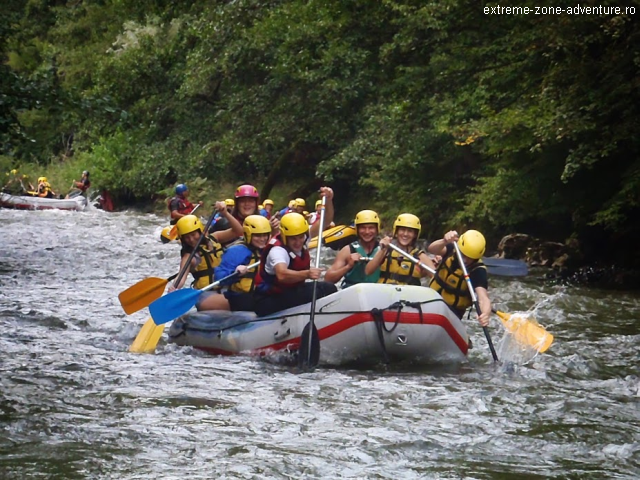Tourism and adrenaline on Romania’s rivers
Every weekend as many as 1,000 tourists practice nautical sports on five of Romanias rivers, although the natural potential of these rivers would allow around 3,500 up to 4,000 people to practice such sports. In todays edition of “Travelers Guide wel

Daniel Onea, 27.11.2014, 13:06
One of the favorite destinations for thrill seekers is the Crisul Repede Gorge in the Bihor county, in northwestern Romania. One can practice sports on an area of about 48 kms, where the rivers cuts its way through cliffs that reach 80 meters in certain locations. The Crisu Repede river is a second-degree river, which means that it is ideal for family rafting and team building, says Adrian Iohas, the manager of a company from Vadul Crisului.
Adrian Iohas: “Every weekend tourists come for rafting and team building. They always return with pleasure because our team uses all its resources to make people feel good. 30% of the tourists who come to visit us are foreigners, mainly from Hungary. The river is perfect for rafting. We train many children for this sport, and they enjoy it very much. Unlike others, we promote rafting for people with disabilities. Each year we organize in Romania a rafting tournament for people in wheelchairs, and we sponsor the rafting competition for the people with disabilities. I guess what we have been doing for 4 years is unique in the world. Rafting is the emblem of Bihor county.”
In one of the previous editions of “Traveler’s Guide” we told you that Romania could rely on its own salt resources for the coming one thousand years. But what is the link between salt and rafting? Here is Adrian Iohas, talking about the Romanian rafters of yore.
Adrian Iohas: “In the 18th and 19th centuries salt was being transported from Romania to Hungary. This year we marked the 46th edition of the Salt Customs in Vadul Crisului, in early June. On the occasion we made a demonstration using a raft built only of wood, according to traditional methods. The oars are also made of wood. The boys are dressed in folk costumes and they transport salt. We also have a customs officer, to recreate the atmosphere of times past. Salt used to be transported by carts from the Praid salt mine up to Huedin, from where it would be uploaded on rafts. The rafts would reach as far as Hungary. There, people would sell the salt and wood, and then return home using other means of transport. When crossing the border the rafters had to pay customs duties consisting in a lump of salt. Each June as many as 2 thousand people come to see this demonstration”.
If you are curious to learn about the profile of the tourists seeking adventure, their ages range between 15 and 80 years and they have average incomes. But quite frequently children under 7 take part in river rafting competitions, says Dan Panturu, the manager of a company from Brasov: “Rafting is ideal for both people who want to practice it on their own or in teams, it’s a synchronicity sport, with a designated leader, which is perfect for the Romanian and foreign team building activities. The rivers on which rafting can be practiced are located in disadvantaged, poor areas, but this could be turned into an advantage because the whole experience is like going back in time. The outdoor activities, such as rafting, can generate profit. Not only for the company making the offer but also for the whole area. We practice rafting on various sectors of the river, with both grown-ups and children, in conditions of maximum safety for everyone. We would like more and more people to discover these adrenaline-producing sports than can be practiced in total safety.”
If we look at Romania’s rivers, we could say that we are covered by water, according to Sabin Cornoiu, the director of the Gorj County Mountain Rescue Public Service: “The tourists who are now coming to Romania can practice rafting, kayak and canoe sports, abseiling in waterfalls, free diving and also cave diving. There are many sports that can be practiced in water and that can be combined with mountain-specific activities. All these activities are well prepared, on various degrees of difficulty, so that they can be approached both by beginner and advanced sports lovers. We believe that those who visit Romania will also discover these sports, beside the country’s culture, history, traditions and people’ hospitality. There are many areas in Romania worth visiting where to practice such sports like the north of the southern region of Oltenia, Moldavia (in the east), Transylvania and the north of Romania.”
Foreign tourist operators have become aware of the potential Romania has in this respect and have started to show interest in the programs Romania has to offer. Here is Catalin Campeanu with details: “Romania is perceived as a country with an incredibly wild nature, where animals still enjoy the wilderness. Westerners who come to Romania have the opportunity to take a leap back in time, 100 years back. People are looking for what they don’t have in their countries any more. For example the Danube Delta is a hot spot with tourists from Germany, Austria, UK and many other countries, who are mainly into kayaking.”
We’ll go back to the north of the country to let Adrian Iohas, from Vadul Crisului, extend a special invitation to you all: “We’ll be organizing a special bachelor’s rafting day with a lot of surprises. The future bridegroom will be surprised in a variety of ways. We have friends who promote these activities in the city of Cluj. Last year we had 5 bachelor’s parties on water. The future bridegrooms came with their eyes covered, they didn’t even know where they were taken”.
Prices for river rafting vary according to area and the group size, and start from 40 euros for a one-hour-and-a half ride for a group of 6. For a complete offer, including transport to the destination and accommodation, call your tour operator right now. We hope we have convinced you that it’s worth coming to Romania if you are seeking thrill and adrenaline. Until our next encounter, have a nice trip and good weather!






























